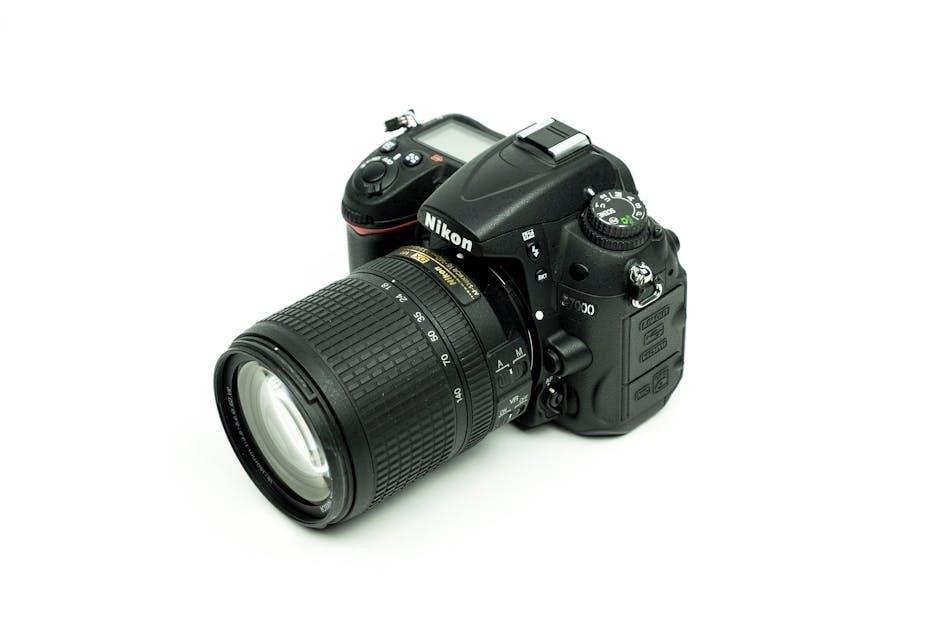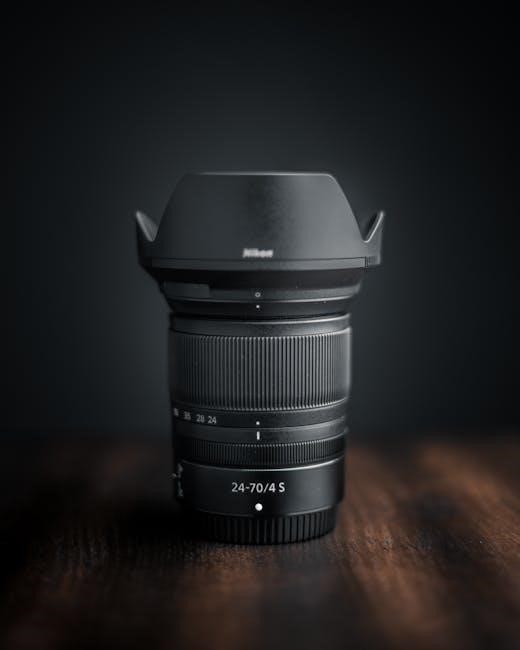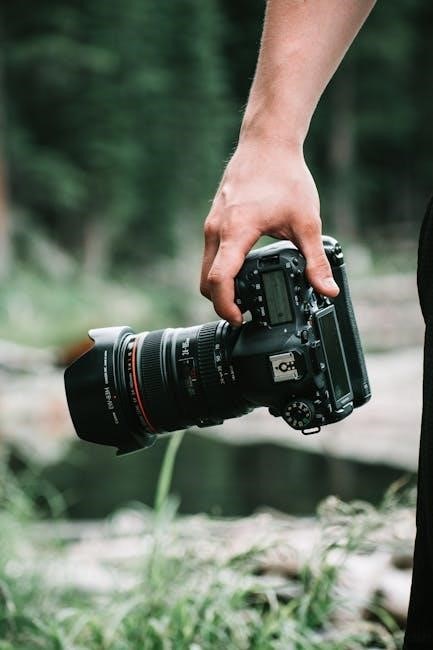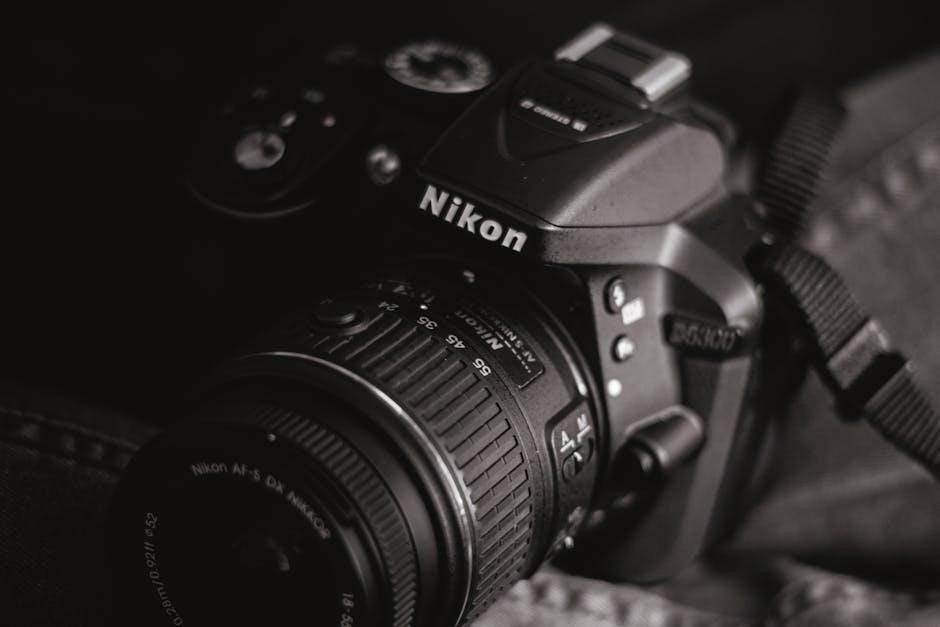nikon 50d manual
The Nikon D50 is a 6-megapixel DSLR camera released in 2005, known for its user-friendly design and excellent image quality. This manual guides users through its features, ensuring optimal performance and helping photographers master its capabilities for stunning results.
1.1 Overview of the Nikon D50 Camera
The Nikon D50 is a 6-megapixel DSLR camera introduced in 2005, designed for entry-level photographers. It features a compact, lightweight body and an intuitive interface, making it ideal for beginners. The camera uses a CCD sensor and supports Nikon F-mount lenses, offering versatility for various shooting scenarios.

With automatic modes and manual controls, the D50 balances ease of use with creative flexibility. Its 2.0-inch LCD screen and built-in flash further enhance its functionality, providing a comprehensive tool for capturing high-quality images with minimal effort.
1.2 Importance of Understanding the Manual
Understanding the Nikon D50 manual is crucial for unlocking its full potential. It provides detailed insights into camera settings, features, and troubleshooting, ensuring optimal performance. By mastering the manual, users can enhance image quality, resolve common issues, and explore advanced photography techniques. This guide is essential for both beginners and experienced photographers, offering tips to maximize the camera’s capabilities and improve overall shooting experiences. Regularly reviewing the manual helps users stay updated and make the most of their Nikon D50.
Key Features of the Nikon D50
The Nikon D50 features a 6.1-megapixel sensor, 2.0-inch LCD, and 18-55mm kit lens, offering excellent image quality and user-friendly operation for photographers of all levels.
2.1 Sensor and Image Quality
The Nikon D50 features a 6-megapixel APS-C CMOS sensor, delivering sharp and vibrant images with excellent color accuracy. The sensor’s design ensures detailed captures, even in challenging lighting conditions. With an effective pixel count of 6.1 million, it produces high-quality photos suitable for both casual and enthusiast photographers. The camera’s image processor enhances clarity and reduces noise, making it ideal for everyday photography and creative projects. Its sensor technology balances detail and dynamic range, ensuring consistent results across various shooting scenarios.
2.2 ISO Range and Noise Performance
The Nikon D50 offers an ISO range of 200 to 1600, providing flexibility in various lighting conditions. At lower ISOs (200-400), images are sharp with minimal noise. As ISO increases, noise becomes more apparent, especially at 1600. The camera handles noise well for its class, but best results are achieved at lower settings. This makes it suitable for everyday photography while maintaining image quality in low-light scenarios.
2.3 Autofocus System
The Nikon D50 features a responsive 5-area autofocus system, ensuring sharp images even in challenging lighting conditions. It offers predictive focus tracking for moving subjects and operates quietly, making it ideal for candid shots. The AF system is user-friendly, with options to select focus areas manually or automatically, enhancing versatility for various photography scenarios. This feature-rich system is designed to deliver precise focus control, helping photographers capture moments with clarity and confidence.
Camera Design and Ergonomics
The Nikon D50 features a durable, lightweight design with an ergonomic grip, ensuring comfort during extended use. Its intuitive button layout enhances accessibility and operational ease for photographers.

3.1 Build Quality and Durability
The Nikon D50 features a sturdy construction with a durable plastic body, ensuring reliability even with frequent use. Its ergonomic design provides a comfortable grip, while the camera’s weather-sealed buttons protect against dust and moisture. The D50’s build quality is robust for its class, making it a reliable choice for photographers seeking a durable DSLR. Its long-lasting battery life and solid engineering ensure it withstands the demands of regular photography sessions, maintaining performance over time.
3.2 Button Layout and Accessibility
The Nikon D50 features an intuitive button layout designed for easy access to key functions. The camera’s ergonomic design places frequently used controls, such as ISO, white balance, and AF-mode buttons, within convenient reach. The LCD screen provides clear menu navigation, while the viewfinder offers essential shooting information. This user-friendly setup ensures quick adjustments, making it ideal for both beginners and experienced photographers. The accessibility of controls enhances the overall shooting experience, allowing for seamless operation in various photography scenarios.
3.3 Viewfinder and LCD Screen
The Nikon D50 features a bright and clear optical viewfinder, providing 95% frame coverage for accurate composition. The 2-inch LCD screen offers a 230,000-dot resolution, enabling precise image review and menu navigation. The viewfinder’s diopter adjustment ensures sharp focus for users with vision impairments. The LCD’s wide viewing angle and anti-reflective coating enhance visibility in various lighting conditions, making it ideal for both indoor and outdoor photography. These features combine to deliver a seamless shooting and reviewing experience for photographers of all skill levels.

Shooting Modes
The Nikon D50 offers various shooting modes, including automatic, semi-automatic, and manual options, catering to both beginners and advanced photographers for flexible and creative photography experiences.
4.1 Automatic Modes
The Nikon D50 offers multiple automatic modes designed to simplify photography for users of all skill levels. These modes, such as Auto, Portrait, Landscape, and Night Portrait, automatically adjust settings like aperture, shutter speed, and ISO for optimal results. The camera analyzes the scene and selects the best parameters, making it easy to capture high-quality images without manual adjustments. This feature is particularly useful for beginners or those who prefer a hassle-free shooting experience, ensuring sharp and well-exposed photos in various lighting conditions.
4.2 Semi-Automatic Modes
The Nikon D50 offers semi-automatic modes like Aperture Priority (A) and Shutter Priority (S), allowing users to control specific settings while the camera adjusts others. Aperture Priority enables manual aperture adjustment for depth of field control, while Shutter Priority lets users set shutter speed to capture motion or freeze moments. These modes provide flexibility for creative photography, making them ideal for learning and experimenting with different techniques without fully manual operation.
4.3 Manual Mode
Manual Mode (M) offers full creative control, allowing users to adjust aperture, shutter speed, and ISO independently. This mode is ideal for experienced photographers who want precise control over exposure. It enables customization of settings to achieve specific artistic effects, such as freezing motion or creating motion blur. While it requires a good understanding of photography basics, Manual Mode unlocks the Nikon D50’s full potential for capturing unique and professional-quality images.
Autofocus and Metering
The Nikon D50 features a precise autofocus system with modes like Single AF and Continuous AF, while its metering system includes Matrix, Center-Weighted, and Spot options for accurate exposure control.
5.1 Autofocus Modes
The Nikon D50 features three autofocus modes: Single Shot AF, Continuous AF, and Manual Focus. Single Shot AF locks focus on a stationary subject, while Continuous AF tracks moving subjects. Manual Focus allows precise control for creative shots. These modes ensure versatility, catering to various photography needs, from portraits to action shots, enhancing overall shooting efficiency and image clarity. Customization options further refine autofocus performance, making the D50 adaptable to different scenarios and user preferences.
5.2 Metering Modes
The Nikon D50 offers three metering modes: Matrix, Center-Weighted, and Spot. Matrix metering analyzes the entire scene for balanced exposure. Center-Weighted prioritizes the central area, ideal for portraits. Spot metering measures a small area for precise control in challenging lighting. These modes help photographers achieve accurate exposures, enhancing creativity and image quality in various conditions.

Image Quality Settings
The Nikon D50 offers customizable image quality settings, including resolution options and compression levels, ensuring sharp and detailed photos. Adjustments to white balance and color modes enhance accuracy and creativity.
6.1 Resolution and Compression
The Nikon D50 offers a maximum resolution of 3,008 x 2,000 pixels, delivering crisp images for its 6-megapixel sensor. It supports various image sizes, including 2,976 x 1,964 and 1,984 x 1,320 pixels. Compression options include Fine, Normal, and Basic JPEG settings, allowing users to balance file size and quality. Higher compression reduces file size but may compromise detail. For optimal results, use the Fine setting for important shots and Normal or Basic for everyday captures, ensuring efficient storage without sacrificing image integrity.
6.2 White Balance and Color Modes
The Nikon D50 offers multiple White Balance settings, including Auto, Daylight, Cloudy, Shade, and Fluorescent, to ensure accurate color reproduction in various lighting conditions. Additionally, the camera features color modes like Standard, Vivid, and Neutral, allowing photographers to customize the look of their images. These modes enhance contrast, saturation, and sharpness, providing flexibility for creative expression. Understanding and utilizing these settings can significantly improve image quality and visual appeal, making the D50 a versatile tool for capturing stunning photos.
Memory and Storage
The Nikon D50 supports various memory cards, ensuring efficient storage solutions. Proper formatting and management are essential for optimal performance and data security.
7.1 Compatible Memory Cards
The Nikon D50 supports SD and SDHC memory cards, ensuring ample storage for high-quality images. For optimal performance, use cards with capacities up to 4GB for SD and 8GB for SDHC. Always format cards in-camera for compatibility and reliability, avoiding data loss. Choosing the right card ensures smooth operation and efficient data management, enhancing your photography experience with the Nikon D50.
7.2 Formatting and Data Management
Regular formatting of memory cards is essential to prevent data corruption and ensure compatibility with the Nikon D50. Always format cards in the camera via the menu, not on a computer, to maintain proper file structure. Use a low ISO setting for faster formatting. Backup important images before formatting to avoid data loss. The D50 supports various memory card types, and proper data management ensures efficient workflow and image quality. Organize files systematically for easy access and archiving.
Battery and Power Management
The Nikon D50 uses an EN-EL9 battery, offering excellent performance. For optimal use, charge it with genuine Nikon chargers. Enable power-saving features like auto-off and reduce LCD usage to extend battery life.
8.1 Battery Life and Performance
The Nikon D50 uses EN-EL3 batteries, offering excellent performance with up to 2,000 shots per charge. Its efficient power management ensures longevity, even with frequent use. The camera’s battery life is impressive for its class, making it suitable for extended shooting sessions. Proper maintenance, such as avoiding extreme temperatures and updating firmware, can further enhance performance. Users can also monitor battery levels via the LCD screen for better power management.
8.2 Charging and Power Saving Tips
To maximize the Nikon D50’s battery life, charge the EN-EL3e battery with the provided MH-18a charger. Avoid overcharging, as it can reduce battery longevity. Turn off unnecessary features like the LCD preview and auto-focus assist light when not in use. Use power-saving mode to extend shooting sessions. Store spare batteries in a cool, dry place to maintain their performance. Regularly clean battery contacts to ensure proper charging and camera operation.

Accessories for the Nikon D50
Enhance your Nikon D50 experience with compatible lenses, flashes, and remote controls. These accessories improve functionality, creativity, and convenience for diverse photography needs and scenarios.
9.1 Lenses
The Nikon D50 is compatible with a wide range of Nikon F-mount lenses, offering versatility for various photography needs. The Nikon 70-200mm f/2.8 FL is a popular choice, praised for its sharpness and ideal focus performance. While it excels in image quality, its size and weight make it less practical for casual use. Choosing the right lens depends on your photography style, ensuring optimal results for portraits, landscapes, or wildlife photography.
9.2 Flashes and External Lighting
The Nikon D50 supports external flashes like the SB-400 and SB-600, enhancing lighting control. These units offer bounce and swivel heads for versatile illumination. Wireless flash operation is also possible, expanding creative possibilities. External lighting solutions improve image quality by reducing harsh shadows and enhancing color accuracy. Users can explore various flash modes to achieve desired effects. Proper synchronization with the camera ensures optimal results. Consult the manual for detailed setup and customization options to maximize the potential of external lighting systems.
9.3 Remote Controls and Tripods
The Nikon D50 is compatible with remote controls and tripods, enhancing stability and convenience. Using a remote control reduces camera shake during tripod-mounted shots, ideal for long exposures or group photos. The MC-DC2 remote cord is recommended for reliable operation. Tripods ensure sharp images, especially in low-light conditions, by minimizing movement. These accessories are essential for professional-grade photography, allowing users to capture precise and steady shots effortlessly.
Troubleshooting Common Issues
10.1 Error Messages and Solutions
The Nikon D50 may display error messages like “ERR” or “FOR.” These often indicate issues with memory cards or lens connections. Cleaning contacts or formatting cards usually resolves these problems.
10.2 Camera Maintenance Tips
Regularly clean the sensor and lens to prevent dust spots. Update firmware and use compatible accessories to ensure optimal performance and avoid common operational issues.
10.1 Error Messages and Solutions
The Nikon D50 may display error messages like “ERR” or “FOR,” indicating issues such as lens communication problems or memory card errors. Solutions include turning the camera off and on, checking lens connections, or formatting the memory card. Regularly cleaning the sensor and ensuring firmware updates can prevent errors. Refer to the manual for specific solutions to maintain optimal performance and resolve issues promptly, ensuring uninterrupted photography sessions with your Nikon D50.

10.2 Camera Maintenance Tips
Regularly clean the sensor and lens to prevent dust and smudges. Use a soft brush or cleaning solution for the sensor, and a microfiber cloth for the lens. Store the camera in a dry, cool place to avoid moisture damage. Avoid extreme temperatures and humidity. Update firmware periodically to ensure optimal performance. Check for firmware updates on the official Nikon website. Proper maintenance ensures longevity and consistent image quality, keeping your Nikon D50 in excellent condition for years of reliable use.

Conclusion
The Nikon D50, a 6-megapixel DSLR from 2005, offers excellent image quality and user-friendly operation. This manual provides comprehensive guidance to help photographers master its features and settings, ensuring optimal performance and creative control for capturing stunning memories.

11.1 Final Tips for Mastering the Nikon D50
To fully master the Nikon D50, practice regularly and experiment with its shooting modes. Understand ISO settings to optimize image quality in various lighting conditions. Regularly clean the sensor and lenses for sharp results. Familiarize yourself with the autofocus system for precise subject capture. Explore external accessories like lenses and flashes to enhance creativity. Organize your memory cards and files efficiently. By following these tips, you’ll unlock the camera’s potential and achieve professional-grade photography with ease and confidence.